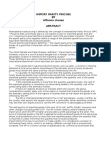IMPORT PRICING.docx
By Alfonso Llanes
ABSTRACTInternational trade pricing is defined by the concept of International Parity Price or (IPP), “The price that a purchaser pays or can expect to pay for imported goods; thus the (c.i.f.) import price plus tariff plus transport cost to the purchaser's location. This and the export parity price together define a range of the possible equilibrium prices for equivalent domestically produced goods”.The UN World Food Program definition: “The import parity price (IPP) is the price at the border of a good that is imported, which includes international transport costs and tariffs”.The USAID Market and Trade Glossary definition: "Import parity price (IPP) – is the monetary value of a unit of product bought from a foreign country, valued at a geographic location of interest in the importing country".These definitions are used in International trade and are sometimes referred to as the International Benchmark which describes the same thing (IPP):• If the goods don’t require production inputs, such as water, a mineral or farming, obtained at local prices before import/export the domestic price of locally produced goods must remain the same and may not be influenced by the IPP.• If a quantity of imported goods is less than the quantity available locally, the locally produced goods must continue to be sold at their local prices and the cost of the imported quantity covered by its value being added to the quantity cost of the goods being sold in the domestic market.• If the imported quantity is more than the quantity available locally, the cost of the imported quantity is covered by its value being added to the quantity cost of the goods being sold in the domestic market.• If there are regional divisions or markets within the country, the above considerations usually apply only to the region or market that imports the goods; and the domestic selling price in the regions or markets that do not import the goods is not affected by the IPP.• The IPP or International Benchmark Price is 'set' periodically- usually monthly- by the country that exports the largest volume of a commodity. Other exporting countries may set their own export prices or use the IPP, whichever is advantageous to them.The selling price of imported goods is the sum of its cost, tariffs, freight, insurance and other charges including profits (CIF). The IPP is often used by sellers instead of the import price when the IPP is higher and provides a profit advantage to the seller. The price of imported goods or the IPP is applied to locally produced goods of the same type whose local-production price is lower than the imported goods unless the quantity that is imported is vastly more than the quantity that is locally produced.Import Parity Price has no economic or trade validity. It is considered a variation of Purchasing Power Parity, which is an entirely different concept that is economically accepted. The IPP is a recent concept of globalization by commercial businesses that enables them to profit from imports and/or exports. The IPP cannot therefore be a policy to determine the local selling price of a locally produced commodity. Developed countries do not use the IPP to determine local selling prices; instead, prices are determined by the local production cost.